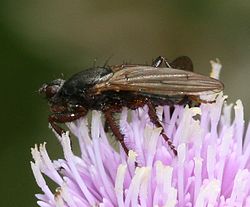Coelopidae
| Seaweed or kelp flies | |
|---|---|
 |
|
| Scientific classification | |
| Kingdom: | Animalia |
| Phylum: | Arthropoda |
| Class: | Insecta |
| Order: | Diptera |
| Section: | Schizophora |
| Subsection: | Acalyptratae |
| Superfamily: | Sciomyzoidea |
| Family: |
Coelopidae Hendel, 1910 |
| Subfamilies | |
|
|
The Coelopidae or kelp flies are a family of Acalyptratae flies (order Diptera), they are sometimes also called seaweed flies, though both terms are used for a number of seashore Diptera. Fewer than 40 species occur worldwide. The family is found in temperate areas, with species occurring in the southern Afrotropical, Holarctic, and Australasian (which has the most species) regions.
For terms see Morphology of Diptera
Coelopids are small to medium-sized (2.5–9 mm, usually 4–7 mm), robust flies, predominantly with a flat body and darkly coloured. Coelopidae species are usually densely bristly or hairy. Their eyes are small. The arista is bare to pubescent. Ocelli and ocellar bristles are present. The postvertical bristles are parallel or converge. The two pairs of frontal bristles curve outward and scattered interfrontal setulae are present. Vibrissae are absent, but strong bristles occur near the vibrissal angle. The mesonotum is flat and the prothorax is separated from the propleuron by a membrane. The legs bear strong bristles and soft, dense hairs and the tibiae have subapical bristles. The wing is unmarked. The costa is entire, without interruptions. The subcosta is complete, crossvein BM-Cu is present, and the anal cell (cell cup) is closed. Legs usually densely hairy.
Coelopids are found in the wrack zone of temperate seashores where the larvae feed on rotting seaweed. They are sometimes very abundant in this habitat. They go through several generations a year. The females lay their eggs in small batches into fresh alga banks. Three larval instars occur. Larvae feed in a bacteria-laden mass. Pupation is seldom in the algal substrate that soon collapses, but more frequently in the highest sand layers. Larvae are also found in winter wrack heaps as bacteria raise temperatures to 20-30 °C even if the heap is superficially frozen. Larvae and pupae have numerous predators, including birds and the staphylinid Aleochara and suites of parasites confined to algal banks.
...
Wikipedia
